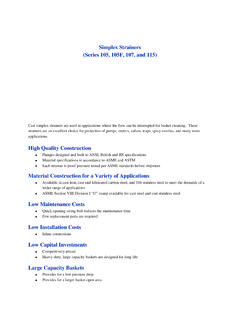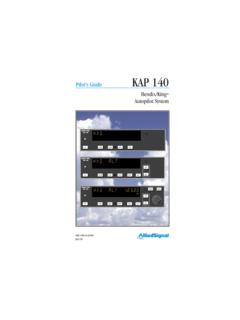Transcription of Fluid Engineering
1 Engineered Products for Demanding Applications, Performance, and Service 1432 Walnut Street Erie, PA 16502-1746 USAP hone (814) 453-5014 Fax (814) 452-6573 Email: Web: EngineeringA Division of TM Industrial Supply, Inc. * An Employee-Owned CompanyThe Eliminator The Hyper-Jet automatic Self-Cleaning Strainer/Filter Systems2 Series 700 Eliminator The Eliminators , motorized, automatic , self-cleaning strainers by Fluid Engineering , provide continuous debris removal from Fluid piping systems that demand full time uninterrupted Eliminators are particularly effective in Fluid applications where unattended service.
2 High solids loading and/or uninterrupted flow requirements deem a basket strainer and its attendant maintenance problems impractical. Any of the Fluid Engineering 700 Series Strainers, applied correctly, will prove efficient and cost effective compared to simplex/duplex strainers or other automatic straining Eliminator Model 723/723T/753/793 PROVEN FEATURES INCLUDEP atented rugged screen and mechanical assist backwash mechanism extends useful service clog-resistant straining element reduces maintenance adjustable accelerator plate aids cleaning in difficult internal replacement parts supplied in corrosion resistant proven design reduces maintenance requirements.
3 Requires fewer for manual operation in case of power rpm backwash mechanism provides more efficient cleaning, less wear of Eliminator s patented unique strainer element design permits installation in virtually any piping system operating at a positive Eliminators can operate through a wide range of operating pressures (10 psig minimum) and solids loading with effective debris removal and backwashing across the entire pressure range. Additionally, only one drain/backwash connection is required for installation effectively eliminating the expense of a separate backwash are used to protect equipment such as valves, pumps, meters, heat exchangers, or spray nozzles, as well as in feed water and process water applications or virtually any similar Eliminator 700 Series automatic Self-Cleaning Strainers are fabricated in pipe sizes ranging from 1 to 48 to suit most application 700 Eliminator How the 700 SeriesEliminator works1.
4 Debris laden Fluid enters through inlet to inner chamber (Figure 1a).2. Dirty Fluid flows upward to the strainer element (A).3. Debris is retained on the flat face of the strainer element, while stained Fluid continues to outer chamber and exits through strainer outlet (See Figure 1a).4. During backwash or cleaning cycle, the motor/gear reducer (B) is engaged and drives the hollow drive shaft (C) and hollow port (D) around the inner circumference of the strainer The backwash assembly C, D, and E are opened to atmospheric pressure by opening the backwash control valve (not shown).
5 6. Flow reversal occurs at the port/straining element (F) interface because of the pressure differential described in 5 (See Figure 1b).7. Debris is effectively vacuumed from the full length of the straining element by a vigorous reverse Fluid flow and into the hollow port; down the hollow drive shaft and out the backwash outlet (G).8. The hollow port continues to sweep the full length of the strainer element until the cleaning cycle has A brush molded to the port shoe facilitates debris removal on the straining element (See Figure 1c).
6 A non-brush port shoe is available as an The strainer will provide continuous uninterrupted Fluid flow during the cleaning The cleaning cycle can be set for continuous or intermittent backwash. Patent No. 4,818,402 Canadian Patent No. 1,314,235 Figure 1aBRUSH WITHLIGHT CONTACTSCREENPORTSHOEBRUSH ATTACHMENTPATENT No. 5,595,655 Figure 1bFigure 1c4 Series 700 Hyper-Jet The Hyper-Jet is Fluid Engineering s additional line of motorized, automatic self-cleaning strainers. On Fluid piping systems, which demand added cleaning abilities due to application requirements, the Hyper-Jet provides continuous uninterrupted debris Hyper-Jet is very effective in system applications where operating pressure is low (under 5 psig) or where the system debris has particularly difficult removal characteristics.
7 Fluid Engineering s 721/751 Series strainer provides unattended service with the addition of external backwash Fluid that enhances the self-cleaning attribute over other automatic Hyper-Jet s unique patented backwash system coupled with Fluid Engineering s strainer element design permits installation in a broader range of system applications. This scope of operations includes from relatively low pressure to very high pressure and from withdrawing coarse, easily removed debris to fine, sticky a low pressure mode (such as on the suction side of a pumping system), the Hyper-Jet system is mounted on the leading edge of the strainer backwash arm (Fig.)
8 2). External Fluid is directed at an incident angle over the inside surface of the straining element through the high-pressure nozzle assembly. The high velocity of this spray assists the cleaning of the wedge-wire straining element. External source pressure must be a minimum of 30 psi over system operating strainers are used to protect equipment such as pumps, motors, heat exchangers, or spray nozzles, as well as process applications such as cooling towers or virtually any similar Series 721/751 Hyper-Jet Self-Cleaning Strainers are fabricated in pipe sizes ranging from 1 to 36 to suit most application requirements.
9 The Hyper-Jet System can also easily and economically be field installed in any Fluid Engineering Self-Cleaning Strainer (6 size and larger) in service as a retrofit FEATURES INCLUDEA unique patented spray assisted/ mechanical backwash mechanism for extended service clog-resistant straining element (wedge- wire configuration) to reduce maintenance downtime and operator assisted internal replacement parts supplied in corrosion resistant materials (special material available on request).An efficient, effective cleaning mechanism which reduces annual maintenance, requiring fewer low rpm backwash cycle provides more efficient cleaning, less wear (no contact between rotating parts) and longer duty cycle on motors and speed existing Eliminator (6 and up) can be converted to the Hyper-Jet.
10 The Hyper-Jet Model 721/751 Figure 2 - The Innovative Internals of the Hyper-Jet 5 Series 700 Hyper-Jet 1. Debris laden Fluid enters through inlet to inner chamber (Figure 3a).2. Dirty Fluid flows upward to the strainer element (A).3. Debris is retained on the flat face of the strainer element, while strained Fluid continues to outer chamber and exits through strainer outlet (See Figure 3a).4. During backwash or cleaning cycle, the motor/gear reducer (B) is engaged and drives the hollow drive shaft (C) and hollow port (D) around the inner circumference of the strainer The backwash assembly (C), (D), and (E) are opened to atmospheric pressure by opening the backwash control valve (Not shown).






